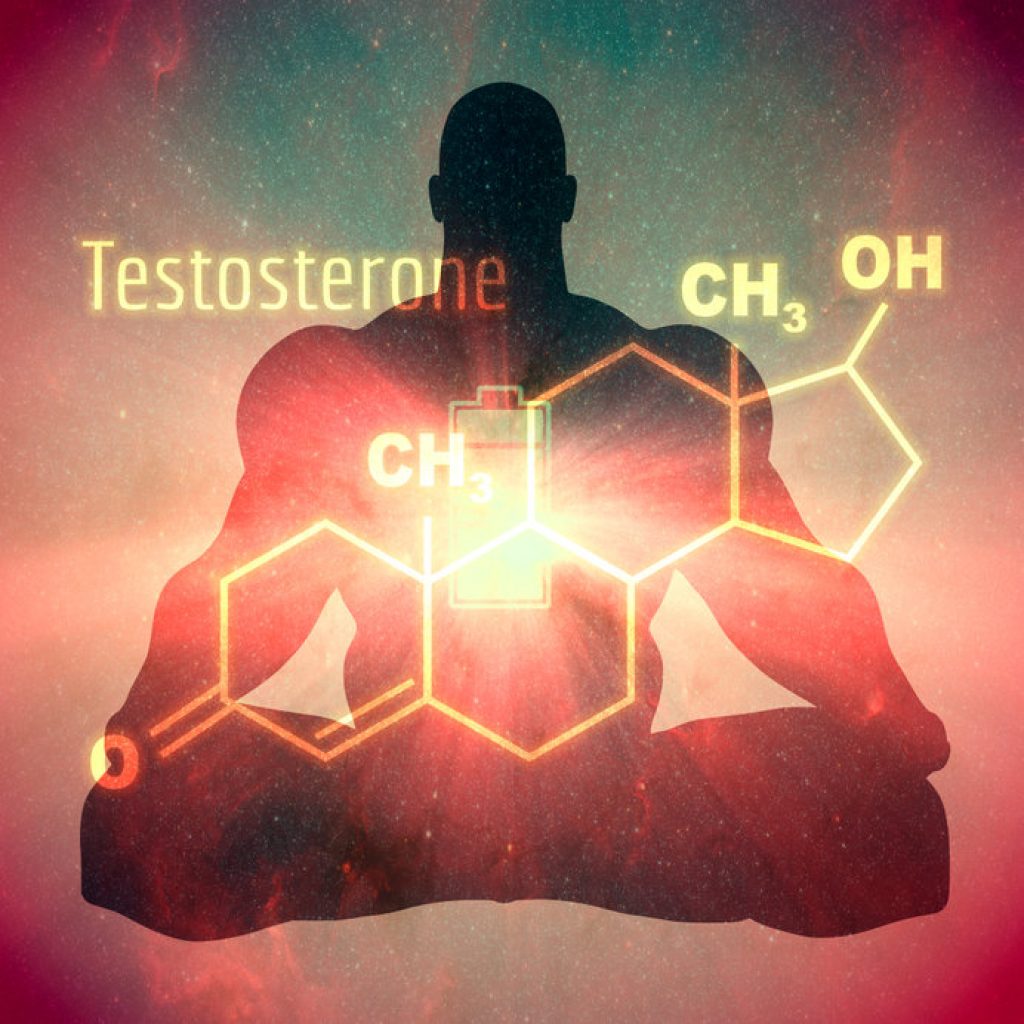STEPHEN W. PARCELL, ND
It is not unusual for naturopathic doctors to encounter male patients with late-onset hypogonadism (LOH). This term, like “male menopause,” “andropause,” and “testicular hypofunction” refers to an abnormally low testosterone (T) level. When chronic, low T in men can contribute to low muscle mass and strength, decreased bone mineral density, and increased fat mass.1,2 Symptoms such as low libido, depressed mood or sense of well-being, forgetfulness, poor concentration, decreased energy, and sleep problems may also be associated with low T but are harder to pin down due to the multifactorial nature of these symptoms.1
In men, low serum T levels have also been associated with increased risks of atherosclerosis and cardiovascular mortality.3,4 For example, in a 7-year study of men with vascular disease, T deficiency was associated with premature death (hazard ratio [HR], 1.86 for all-cause mortality; HR, 2.50 for vascular mortality).4
Causes of T deficiency include aging, obesity, excessive alcohol intake, hypopituitarism, testicular injury, primary testicular failure, traumatic brain injury (TBI), opioid use, congenital disorders such as Klinefelter’s syndrome, certain medications, and chronic conditions such diabetes mellitus, hemochromatosis, and liver disease.2,5,6
Obesity decreases total testosterone (TT) as a result of hyperinsulinemia-induced reductions in sex hormone-binding globulin (SHBG),7 as well as by lowering both TT and free testosterone (FT) via suppression of the hypothalamic-pituitary-gonadal (HPG) axis.7 Obesity can also cause low T through increased activity of aromatase, the enzyme that converts testosterone to estradiol.2,8 TBI contributes to T deficiency by causing pituitary dysfunction.6 Testosterone levels gradually decline in men after age 50 or so.9 Finally, poor nutrition and lifestyle choices, including high stress and lack of sleep, also likely contribute to low T levels.
Identifying the underlying causes of low T is obviously critical to a successful outcome. Testosterone replacement, however, can be a valuable adjunctive as well as stand-alone therapy for many older men who have low T levels along with associated signs and symptoms. Helpful data has been published over the years on the effectiveness of T replacement in the treatment of erectile dysfunction, low libido, depression, osteoporosis, cognitive impairment, and metabolic syndrome.
Although controversy still exists regarding the benefit/risk ratio of T replacement on Major Adverse Cardiovascular Events (MACE),4 data increasingly support a protective effect.10 T therapy has been shown to improve symptoms of angina by inducing vasodilation in the coronary arteries, also to increase the time for ST depression to occur on treadmill testing.11
Drawing on both research and my clinical experience, this article will discuss the various types of T replacement and how to use them. T therapy does not need to be complicated; once a provider learns the nuts and bolts, it is very easy to do.
Patient Workup
The production of T is controlled by the HPG axis. Gonadotropin-releasing hormone (GnRH) is secreted by the hypothalamus and stimulates pituitary production of luteinizing hormone (LH) and follicle-stimulating hormone (FSH) through feedback loops on the axis, similar to other steroidal hormones in the body. LH regulates T secretion by the Leydig cells in the testes, whereas FSH influences spermatogenesis.12
Male T levels normally fluctuate in a diurnal rhythm, being highest in the early morning and lowest right before bed.1 For this reason, it is recommended that a morning blood sample is used for testing.
The normal range for TT in adult men is 250-1100 ng/dL; the range for FT is 35.0-155.0 pg/mL. Some labs use the direct methodology, which uses a normal range for FT of 6.8-21.5 pg/mL. In general, a diagnosis of low T can be made when TT is below 300 ng/dL on 2 separate morning blood draws.13
If T deficiency is suspected, lab work should ideally include TT, FT, estradiol, prostate-specific antigen (PSA), thyroid-stimulating hormone (TSH), vitamin D, dihydrotestosterone (DHT), FSH, and LH.
If FSH and LH are both elevated and TT is below 200 ng/dL, suspect primary testicular failure. The elevated gonadotropins reflect the pituitary response to low T. If, instead, TT is low but FSH and LH are normal or low, suspect pituitary involvement (ie, secondary hypogonadism).1
If the patient is overweight, I suggest measuring lipids and hemoglobin A1c as well. I recommend getting baseline labs before starting treatment. In the case of suspected pituitary dysfunction (low T and low/normal LH), serum prolactin should also be measured to screen for the rare occurrence of hyperprolactinemia.14 I have found that measuring SHBG is not that helpful because if FT is low and TT is normal, SHBG is probably elevated. This is because SHBG is the main determinant of FT levels. High SHBG can occur with aging, alcohol abuse,15 hyperinsulinemia, increased body mass index,16 and a protein-deficient diet,16 especially in older men.7,10 Unfortunately, SHBG is hard to treat, and sometimes individuals have high levels for no apparent reason.
A patient’s TT may be normal while his FT is low, or vice versa. A symptomatic patient should be treated regardless of the pattern. Keep in mind that you are treating the patient, not the labs. If TT and FT are on the lower side but the patient has no symptoms, treatment can be deferred.
If an overweight or obese man presents with concerns about T, it makes sense to check his endocrine system as part of a comprehensive naturopathic evaluation. Low T in older male patients is not unusual. T replacement therapy in such cases often helps the patient with energy, confidence, drive, and focus. It can also help him stay on task with diet, exercise, and lifestyle modifications, all of which have a much larger impact on body composition.
Testosterone Replacement Therapy
Much has changed in the world of hormone replacement in the 20 years since I graduated from naturopathic medical school. Back in the day, regular insurance-based doctors were reluctant to prescribe testosterone, instead usually referring patients to an endocrinologist. This still occurs today, but to a lesser extent with the advent of more acceptance and good safety/benefit data. In other words, treating LOH is feasible in a primary-care setting and should not typically require referral to an endocrinologist.
An exception would be pituitary concerns. A patient with low T but poor or no response from the pituitary and/or abnormalities in TSH and prolactin should be referred out. One cause of this pattern, and one that is often overlooked, is a history of TBI. In this case, the problem is functional (as opposed to primary testicular failure), involving hypothalamic and pituitary communication with the testicles.6
Injectable T
In the United States, injectable T is bioidentical, but is bound to an ester to increase T’s solubility and half-life.17 There are 3 main types of T ester compounds: cypionate, propionate, and enanthate. T cypionate, the most common form, has the longest half-life at around 8 days.18 Shorter-acting T compounds pose a higher risk of side effects such as edema and acne.
In the past, 200 mg/mL of T in a 10-mL vial was widely available. This was convenient because, at a typical dose of 100 mg per week, the vial would last 20 weeks. Now, due to concerns about bacterial contamination of the vial, most pharmacies will only dispense 1-mL vials at a concentration of 200 mg/mL, providing only 2 weeks’ worth of T for the typical patient. Downsides are that the patient must go to the pharmacy more frequently and there is more waste because there is always some T left in the small vial. Compounding pharmacies, on the other hand, can make a product with lower viscosity, supply more T per vial, and mail it directly to the patient.
Injectable T is convenient because it can be dosed in 1/10th of a mL increment using a 1-mL syringe. Most injectable T is 200 mg/mL, and the typical dose for a man weighing 150-200 lb is 100 mg (0.5 mL) once per week. In my practice, weekly doses given to patients vary, from 0.3 mL to 0.8 mL. Heavier men may need higher doses.
Gluteal injections are the least painful, followed by deltoid and then quadriceps. Some practitioners advise patients to do subcutaneous injections. Be aware that these call for a different dosing strategy of more frequent and very-low-dose injections in order to provide steady-state levels.
There is a new short-acting T enanthate product that comes in an injector pen that makes dosing easy; however, it is much more expensive than generic T cypionate. A recent search on the website drugs.com showed a price of $583 for a 4-week supply at a dose of 100 mg per week. For 10 mL (200 mg/mL) of generic T cypionate, prices range from $60 to around $120.
Patients can be educated on injection technique and sharps protocol. At our practice, we allow patients to bring in their needles and sharps container for proper disposal.
Transdermal T
T pellets, creams, gels, patches, and sublingual troches are all forms of bioidentical T without an ester. Commercially available non-compounded transdermal preparations are also commonly prescribed by conventional physicians. These typically contain less T per gram than compounded T.
Transdermal formulations must be used daily and rubbed into the skin, typically on the inside of both forearms or on non-hairy parts of the chest or shoulder. Because of variability in absorption between patients, hence the potential need to adjust the dose, patients should be monitored regularly. I have found that maintaining consistent T levels is harder when topical preparations are used.
Compared to compounded creams, it is more difficult to control the dose of commercial gels. This is mostly because the product comes with the pump, and the dose is either 1 or 2 pumps. With compounded preparations, the dosage can be customized for the patient. A typical patient will need 100 mg per day of compounded product.
The most common prescription T comes in a 1% or 1.62% gel.17 In order to deliver 50 mg, 5 g of gel is needed. This is a lot of gel.
Be aware that when the patient’s baseline TT level is low-normal (ie, around 300-450 ng/dL), prescribing T at too low of a dose can shut off endogenous production, possibly resulting in even lower T levels. This is because of feedback inhibition on the HPG axis.
Also keep in mind that patients with excessive adipose tissue may need a higher dose of a topical preparation. Additionally, children and women can get unwittingly exposed to T through physical contact with a transdermally treated patient.
Sublingual T
Both oral tablets and sublingual troches are also available from compounding pharmacies. However, there is very low bioavailability of T with oral dosing, so is not recommended. Sublingual is considered a topical route of administration because the medication is administered via the oral mucosa. Uptake of T is quicker through the mucosa than through the skin. The dose is typically the same as with transdermal, and can be customized to the patient. Like any compounded transdermal T formulation, dosing can vary between patients. Compounding pharmacists are an invaluable resource.
T Pellets
Another effective method of T replacement therapy is the T pellet. Small pellets, varying in mg amounts, are inserted beneath the skin in the buttocks area via a small incision using sterile technique. T levels remain consistent and typically last about 4 months before the T level starts to taper off.17 The benefit here is that consistent T levels are maintained over a long-term period. Be aware that out-of-pocket costs are typically $300-$400 every 4 months plus the cost of the pellets (roughly $100-$250).
Adjuncts & Alternatives
Human Chorionic Gonadotropin
The naturally occurring molecule, human chorionic gonadotropin (hCG), has recently been approved by the FDA for the treatment of hypogonadism.19 HCG is similar enough to LH that it binds the LH receptor in Leydig cells, thereby increasing T production.12 This method was originally approved for treating undescended testes during puberty.20
A 2016 study, published in the journal Aging Male, suggested hCG as a preferred treatment for late-onset hypogonadism.21 Leydig cells not only produce T in Leydig cells, but also play a role in the 25-hydroxylation of vitamin D. In this study, hCG treatment in men with LOH improved vitamin D levels and increased T, but without the common T therapy side-effects of hyperestrogenism and polycythemia.21
Some practitioners will cycle hCG with T to prevent testicular atrophy in men on exogenous T.22 A typical cycle would be 3 months on T, followed by 1 month on hCG. Taking the hCG for a month helps prevent T levels from dropping too much and causing symptoms. HCG can also be used as a solo treatment. My own preferred treatment for men on long-term T replacement therapy is to use T with hCG continuously, with no pulsing. I personally like using the combination because sperm count and testicular size can be preserved and less exogenous T is needed. A typical dosing schedule would be 0.4 mL of T cypionate (injection) with 1000 IU of hCG per week.
Clomiphene Citrate
Clomiphene citrate (CC), normally prescribed to women to induce ovulation, is frequently used off-label for the treatment of hypogonadism in men who want to maintain adequate sperm count. CC is a selective estrogen receptor modulator (SERM) that antagonizes estrogen receptors in the hypothalamus and pituitary.23 This serves to disrupt the natural negative feedback of estrogen and stimulates the release of FSH and LH. As a reminder, LH acts on the Leydig cells in the testis to increase T. Tamoxifen may also be used in hypogonadal men to preserve sperm count; however, our experience with tamoxifen has not been as positive as with CC.
Patient Follow-up
For patients being treated with T injections, baseline lab work should ideally include a CBC, CMP, PSA, TT, FT, DHT, and estradiol. Lab tests should be repeated at 3 months. If everything is stable, labs should be repeated every 6 months thereafter. Blood should be drawn on the morning the patient presents for his T injection, prior to the injection and 6-7 days since his last one. Good target blood levels of TT at this point are approximately 450-650 ng/dL. Free T levels can vary quite a bit, so this must be taken into consideration when looking at TT. Conventional physicians may be reluctant to train patients to do their own injections.
Conventional T Replacement: Pros & Cons
I have observed some shortcomings of conventional T therapy. For example, patients may be required get their shots at their doctor’s office every 2 weeks rather than being allowed to self-administer T at home. Additionally, I have found that PSA, estrogen, and red blood cell (RBC) counts are not monitored as frequently as they should be. I do not fault these doctors, as they have their hands full and typically do not have special training in T replacement therapy.
Another problem is the abundance of “Low T” clinics. What I have found with these places is that a medical doctor typically rubber-stamps everything without treating the patient directly. Some low-T clinics also charge excessive amounts in the form of membership dues, upwards of $2000-$3000, and patients are required to pay out-of-pocket for the labs. I see men who have presented to such clinics with completely normal T but were still prescribed T shots, sometimes at a dose so high that they developed dangerous side effects.
In some cases, the lab follow-up is good, but in other cases it falls short. Secondary polycythemia due to the increased erythropoiesis is a common side effect of T replacement therapy, especially where I practice, in high-altitude Colorado. I routinely see patients go for years with hematocrits as high as 55%, yet red-cell depletion as a remedy was never discussed. By the way, this condition can exacerbate a patient’s sleep apnea.
Drawing from my 20+ years of clinical experience, I have listed below my pros and cons of T replacement. Results, of course, vary between patients. An important point is that all possible side effects can be mitigated when patients are treated and monitored properly.
Pros:
- Improvement in erectile function and libido
- Increased fat-free body mass, presuming prudent diet and exercise
- Improved sleep
- Improved cholesterol and triglyceride levels
- Increased energy
- Improved athletic performance, especially at high altitudes, due to increased RBC count; improved vasodilation and oxygen-carrying capacity from increased hematocrit
- Improved exercise performance in endurance athletes who were training upwards of 12 or more hours per week and experienced low T as a result of the endurance training
- Big improvements in mood, confidence, and drive. In some cases, this is the most notable result. I have seen many men make important life-changing decisions after being treated for low T.
Cons:
- Secondary polycythemia. This is an important concern because it increases blood viscosity, which promotes hypertension and increases the workload of the heart, causing arterial damage due to shear stress on the artery wall.1 T-induced polycythemia can be treated with red-cell depletion (500 mL 2-4 times/year).
- Elevated estrogen due to excess aromatization of T in peripheral tissues.1 This can be treated with an aromatase inhibitor (eg, 0.5 mg anastrozole once per week as a starting dose24; diindolylmethane, or DIM, is a natural aromatase inhibitor25). Hyperestrogenism can cause gynecomastia, mood swings, edema, and prostate enlargement.1 Side effects are more likely to occur with larger fluctuations in blood levels of T, as compared to a more steady-state level.
- Acne, which is rare, usually only occurring when a patient is over-treated
- Irritability and impatience
- Elevated blood pressure when the RBC count rises too high and the patient does not donate blood. This occurs because of increased blood viscosity.
- Elevated levels of DHT. Sensitivity to DHT in some men can lead to hair loss and/or prostate enlargement. This can be treated with 5-alpha reductase inhibitors such as saw palmetto.
- Testicular atrophy/shrinkage and infertility.22 This only occurs with exogeneous T administration at excessive doses, and is reversible and does not cause sterility. Complete atrophy is rare. I have found that most older men beyond child-rearing age do not mind a minor decrease in testicle size or fertility. Upon stopping T replacement, testicles return to their baseline size, and sperm count normalizes to original levels.
Reference:
- Bassil N, Alkaade S, Morley JE. The benefits and risks of testosterone replacement therapy: a review. Ther Clin Risk Manag. 2009;5(3):427-448.
- Cosgrove D. Male Hormones. In: Textbook of Functional Medicine. Gig Harbor, WA: The Institute for Functional Medicine; 2010: 234.
- Malkin CJ, Pugh PJ, Morris PD, et al. Low serum Testosterone and increased mortality in men with coronary heart disease. Heart. 2010;96(22):1821-1825.
- Gencer B, Bonomi M, Adorni MP, et al. Cardiovascular risk and Testosterone – from subclinical atherosclerosis to lipoprotein function to heart failure. Rev Endocr Metab Disord. 2021;22(2):257-274.
- Penn Medicine. Testicular Failure. Last reviewed on May 6, 2019. Available at: https://www.pennmedicine.org/for-patients-and-visitors/patient-information/conditions-treated-a-to-z/testicular-failure. Accessed October 15, 2021.
- Wagner J, Dusick JR, McArthur DL, et al. Acute gonadotroph and somatotroph hormonal suppression after traumatic brain injury. J Neurotrauma. 2010;27(6):1007-1019.
- Fui MN, Dupuis P, Grossmann M. Lowered T in male obesity: mechanisms, morbidity and management. Asian J Androl. 2014;16(2):223-231. Available at: https://www.ncbi.nlm.nih.gov/pmc/articles/PMC3955331/pdf/AJA-16-223.pdf. Accessed September 27, 2021.
- Cohen PG. Aromatase, adiposity, aging and disease. The hypogonadal-metabolic-atherogenic-disease and aging connection. Med Hypotheses. 2001;56(6):702-708.
- Seftel AD. Male hypogonadism. Part I: Epidemiology of hypogonadism. Int J Impot Res. 2006;18(2):115-120.
- Morgentaler A, Miner MM, Caliber M, et al. Testosterone therapy and cardiovascular risk: advances and controversies. Mayo Clin Proc. 2015;90(2):224-251.
- Oskui PM, French WJ, Herring MJ, et al. Testosterone and the cardiovascular system: a comprehensive review of the clinical literature. J Am Heart Assoc. 2013;2(6):e000272.
- Ide V, Vanderschueren D, Antonio L. Treatment of Men with Central Hypogonadism: Alternatives for Testosterone Replacement Therapy. Int J Mol Sci. 2020;22(1):21.
- Mulhall JP, Trost LW, Brannigan RE, et al. Evaluation and management of testosterone deficiency: AUA guideline. J Urol. 2018;200(2):423-432. Available at: https://www.auanet.org/guidelines/guidelines/testosterone-deficiency-guideline. Accessed September 27, 2021.
- Park HJ, Ahn ST, Moon DG. Evolution of Guidelines for Testosterone Replacement Therapy. J Clin Med. 2019;8(3):410.
- Iturriaga H, Lioi X, Valladares L. Sex hormone-binding globulin in non-cirrhotic alcoholic patients during early withdrawal and after longer abstinence. Alcohol Alcohol. 1999;34(6):903-909.
- Longcope C, Feldman HA, McKinlay JB, Araujo AB. Diet and sex hormone-binding globulin. J Clin Endocrinol Metab. 2000;85(1):293-296.
- Barbonetti A, D’Andrea S, Francavilla S. Testosterone replacement therapy. Andrology. 2020;8:1551-1566.
- Pfizer. Depo®-Testosterone: Clinical Pharmacology. Available at: https://www.pfizermedicalinformation.com/en-us/depo-testosterone/clinical-pharmacology. Accessed September 28, 2021.
- Krzastek SC, Smith RP. Non-Testosterone management of male hypogonadism: an examination of the existing literature. Transl Androl Urol. 2020;9(Suppl 2):S160-S170.
- Ingerslev HJ, Rasmussen TB. Hormonal behandling af non-descensus testis [Hormonal treatment of undescended testis]. Ugeskr Laeger. 1991;153(9):636-640. [Article in Danish]
- La Vignera S, Condorelli RA, Cimino L, et al. Late-onset hypogonadism: the advantages of treatment with human chorionic gonadotropin rather than Testosterone. Aging Male. 2016;19(1):34-39.
- Lee JA, Ramasamy R. Indications for the use of human chorionic gonadotropic hormone for the management of infertility in hypogonadal men. Transl Androl Urol. 2018;7(Suppl 3):S348-S352.
- Dadhich P, Ramasamy R, Scovell J, et al. Testosterone versus clomiphene citrate in managing symptoms of hypogonadism in men. Indian J Urol. 2017;33(3):236-240.
- Punjani N, Bernie H, Salter C, et al. The Utilization and Impact of Aromatase Inhibitor Therapy in Men With Elevated Estradiol Levels on Testosterone Therapy. Sex Med. 2021;9(4):100378.
- Thomson CA, Ho E, Strom MB. Chemopreventive properties of 3,3′-diindolylmethane in breast cancer: evidence from experimental and human studies. Nutr Rev. 2016;74(7):432-443.

Stephen W. Parcell, ND earned his doctorate in naturopathic medicine from Bastyr University in 2002. Dr Parcell worked as a freelance medical researcher at U of WA Medical School. He has done additional trainings through the ACAM, the National Lipid Association (NLA), AAEM, and the American Academy for Anti-aging Medicine (A4M). He is board-certified in anti-aging medicine through A4M. He is a past vice president of the Colorado Association of Naturopathic Doctors (COAND). Dr Parcell is a paid speaker and educator, has been a contributing writer, published peer-reviewed articles, and authored a book titled Dare to Live. He is co-owner of NatureMed Integrative Medicine, in Boulder, CO. Email: [email protected]





